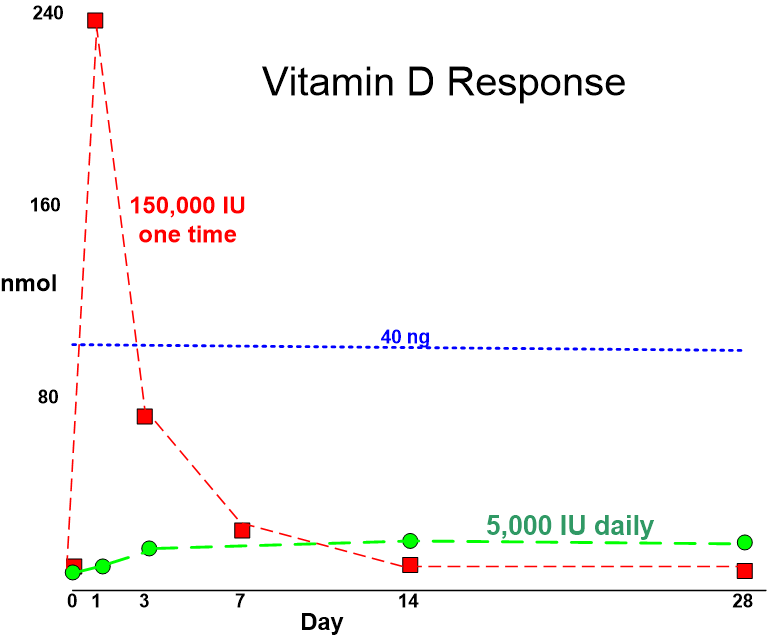Increasing number of people admitted to a hospital in India have very high vitamin D
The increasing problem of subclinical and overt hypervitaminosis-D in India: An institutional experience and review
Nutrition; Available online 6 October 2016; http://dx.doi.org/10.1016/j.nut.2016.09.014

Lokesh Kumar Sharma, MD1, Deep Dutta, MD, DM, MRCP, FACE2, Neera Sharma, MD1, Adesh Kisanji Gadpayle, MD3
1 Department of Biochemistry, Post Graduate Institute of Medical Education & Research (PGIMER) & Dr. Ram Manohar Lohia (RML) Hospital, 1 Baba Kharak Singh Marg, New Delhi 110001, India
2 Department of Endocrinology, Post Graduate Institute of Medical Education & Research (PGIMER) and Dr. Ram Manohar Lohia (RML) Hospital, 1 Baba Kharak Singh Marg, New Delhi 110001, India
3 Director & Medical Superintendent, Post Graduate Institute of Medical Education & Research (PGIMER) and Dr. Ram Manohar Lohia (RML) Hospital, 1 Baba Kharak Singh Marg, New Delhi 110001, India
Highlights
In cohort of 5527 patients, increasing trend for hypervitaminosis-D [25-hydroxyvitamin-D (25OHD)>250nmol/L] from 2011 to 2016 (1·48% to 7·82%)
46.22% and 62.25% patients with hypervitaminosis-D and vitamin-D intoxication (25OHD>375nmol/L) respectively, had elevated calcium or suppressed parathyroid hormone
Children, women and surgical patients are especially susceptible to hypervitaminosis-D
Global secular trend of increase in 25OHD over years. Disturbing trend of increased hypervitaminosis-D in developing world
Empiric, unmonitored, prolonged vitamin-D supplementation, especially intramuscular should be discouraged
Objective: This study aimed to determine the changes in serum vitamin-D distribution at our institute over last 6 years and compare it with global trends.
Methods: Audit of 25-hydroxy-vitamin-D (25OHD), calcium and parathyroid hormone (iPTH) reporting was done from January 2011 to February 2016. References for review were identified through searches of PubMed, Medline, and Embase for articles published till February 2016 using terms “hypervitaminosis-D” [MeSH Terms] OR “vitamin-D toxicity” [All Fields] OR “vitamin-D intoxication” [All Fields].
Results: Reports of 25OHD from 5527 patients were analyzed. Calcium and iPTH were available for 5501 (99.5%) and 1787 (32.3%) patients respectively. Vitamin-D deficiency and insufficiency was observed in 59·4% and 77·3%. Hypervitaminosis-D (25OHD>250nmol/L) was noted in 225 (4·1%) patients, of whom 151 (2·7%) had vitamin-D intoxication (25OHD>375nmol/L). 46.22% (104/225) patients with hypervitaminosis-D and 62.25% (94/151) with vitamin-D intoxication had elevated calcium or suppressed iPTH. Orthopedics, pediatrics and surgery had highest rates of hypervitaminosis-D (7·9%, 7·2% and 7·0% respectively; P<0·001). An increasing trend for hypervitaminosis-D was observed (1·48%, 3·62%, 3·90%, 4·78%, 6.21% and 7·82% in 2011, 2012, 2013, 2014, 2015 and 2016 respectively).
A similar steady upward trend in 25OHD has been reported from Ireland, England, Canada and Australia . However hypervitaminosis-D reports are scant, and has not increased over the years in the developed world.
Conclusion: There is a global secular trend of increase in 25OHD over years. There is a disturbing trend of increased hypervitaminosis-D at our institute. Empiric, unmonitored, prolonged vitamin-D supplementation, using non-recommended supra-physiologic doses, especially intramuscular should be discouraged.
